
views
X
Research source
You can ensure that your cat gets the best nutrition possible by feeding your cat a diet tailored to their needs, stimulating your cat’s appetite, and helping them eat if they need extra assistance or are unable to do so on their own.
Adjusting Your Cat’s Diet

Work with your vet to create a diet plan. While there are some general guidelines for feeding a cat with cancer, your cat’s needs will vary depending on their age, size, overall health, and the type and stage of their cancer. Talk to your vet about the best kind of diet for your cat. Your vet may recommend a prescription cat food, a home-made diet designed to meet your cat’s needs, or some combination of the two.

Decrease your cat’s carbohydrate intake. Too many carbs can feed your cat’s cancer cells, causing the cancer to grow and keeping your cat from getting enough nutrients. Vets recommend that cats with cancer should eat food that contains less than 25% carbs on a Dry Matter Basis (DMB). To calculate the DMB percentage of carbohydrates or any other ingredient in your cat’s food, you can use an online calculator like this one: http://felinenutritioncalculators.com/carbcalorie.html.
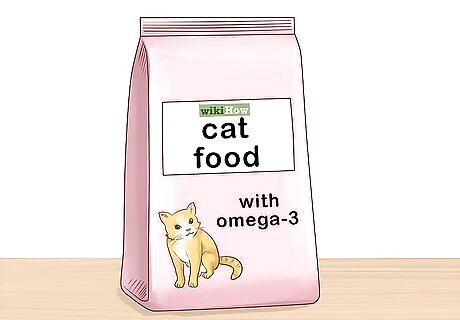
Give your cat foods with a higher fat content. In contrast to carbs, it is much harder for cancer cells to convert fat to energy. Give your cat foods that are relatively high in fat and omega-3 fatty acids, which may actually inhibit tumor growth. Your cat’s food should have a fat content of about 25-40% DMB. Look for foods with at least 5% DMB of omega-3 fatty acids.
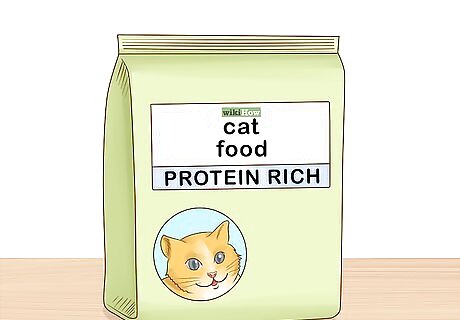
Make sure your cat is getting enough protein. Protein intake is important for helping your cat maintain a healthy lean body mass. In general, cats with cancer should eat a diet containing at least 40-50% DMB of protein. However, be aware that your cat may need to eat a smaller quantity of protein if the liver and kidneys are not functioning properly.
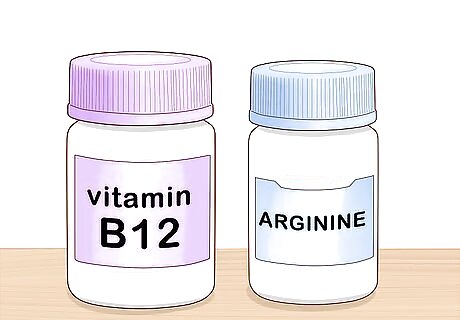
Ask your vet about dietary supplements. In some cases, cats with cancer may benefit from additional dietary supplements, such as arginine (an amino acid that is important for the feline diet) or vitamin B12, which can be especially important for cats with intestinal cancer. Omega 3 fatty acids may also help to improve your cat’s appetite and possibly even inhibit tumor cell growth. You should consult with your vet before starting your cat on any sort of dietary supplement.
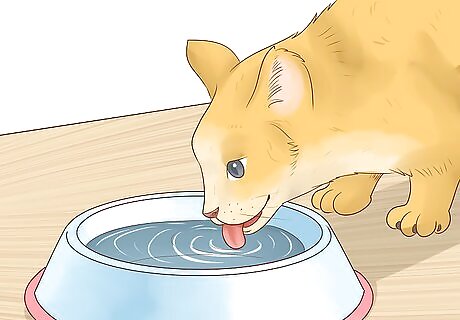
Keep your cat hydrated. Cats with cancer often have trouble getting enough fluids, especially if their kidney function is impaired. Make sure your cat always has access to plenty of fresh, clean water. You can boost your cat’s fluid intake by feeding them a wet food diet or adding water to their kibble.
Stimulating Your Cat’s Appetite
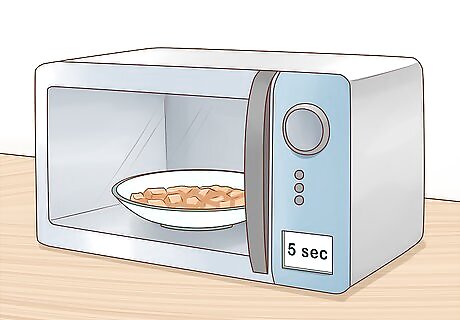
Warm up your cat’s food. If your cat is not showing much interest in their food, you may be able to make it more appealing by warming it up a little bit. This will bring out the aroma of the food. Don’t make the food too hot. It should be no warmer than the normal feline body temperature of about 100 °F (37.78 °C). If you use a microwave, heat the food for about 5 seconds and then stir it up to distribute the heat evenly through the food.

Give your cat multiple small meals. Instead of giving your cat one or two large meals, feed them several small, manageable meals throughout the day. This will prevent uneaten food from sitting in the dish and becoming stale.
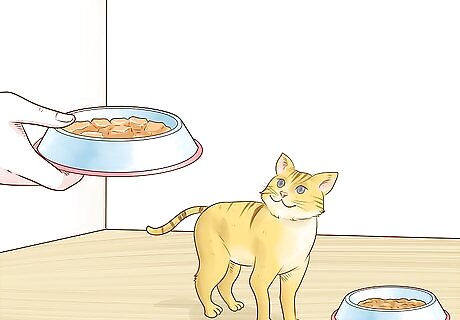
Offer your cat a new food. When your cat is ill, they may come to associate their regular food with feeling sick. If your cat is refusing to eat, sometimes offering a new type of food, or even feeding the cat in a different location from usual, will spark their interest in eating. Before trying any new food, make sure that it meets your cat’s special dietary needs.
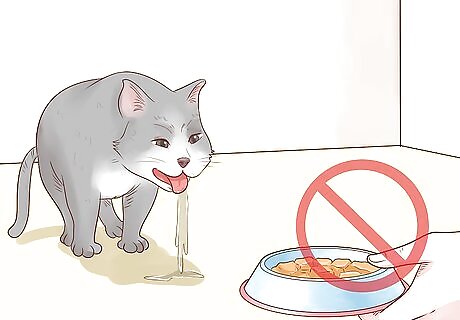
Avoid feeding your cat when they are nauseated. Feeding a nauseated cat can lead them to associate their food with feeling sick, and make them less likely to eat it in the future. If your cat is showing signs of nausea, like drooling while looking at food, spitting out food, or turning away from food when you offer it, don’t keep encouraging them to eat. Your vet may be able to prescribe an anti-nausea medication for your cat. Let them know if your cat is showing symptoms of nausea.

Avoid mixing food and medication, if possible. If your cat’s medication tastes bad or makes them feel nauseated, try to avoid mixing it into their food or administering it too close to a meal. If your cat associates their food with unpleasant medication, it may discourage them from eating. However, keep in mind that some medications need to be given with food to reduce the risk of upset stomach. Talk to your vet and follow the instructions on your cat’s medication.

Ask your vet about giving your cat an appetite stimulant. As a last resort, your vet may prescribe a medication to stimulate your cat’s appetite, such as mirtazapine or periactin. Keep in mind that appetite stimulants are not a long-term solution to eating problems in cats, and they do not work for every cat.
Helping Your Cat Eat
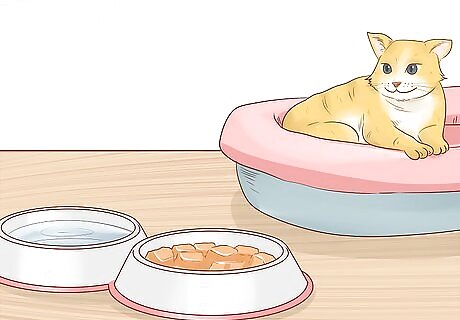
Make food and water easily accessible. If your cat has trouble getting around, keep their food and water in easy-to-reach bowls in the area where they spend most of their time. You may wish to place multiple food and water dishes around the house for easier access.
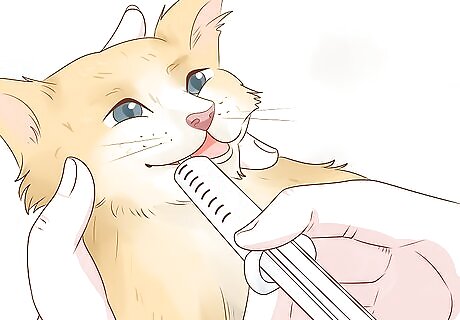
Syringe-feed your cat. If your cat is very weak or extremely malnourished, they may need to be syringe-fed. This involves hand-feeding your cat small amounts of soupy, high-calorie food through a medicine syringe. Ask your vet about the type, amount, and consistency of food that you should administer to your cat via syringe. Lightly warm the food before giving it to your cat. Wrap the cat gently but firmly in a towel to keep them from scratching or struggling during the feeding. Grasp the cat’s head from behind, with your thumb and forefinger resting on the cheekbones, and gently lift the cat’s head. Insert the syringe tip into the cat’s mouth from the side and gently nudge it between the cat’s jaws. Direct the syringe toward the roof of the mouth at a 15° angle and slowly inject the food into the cat’s mouth.
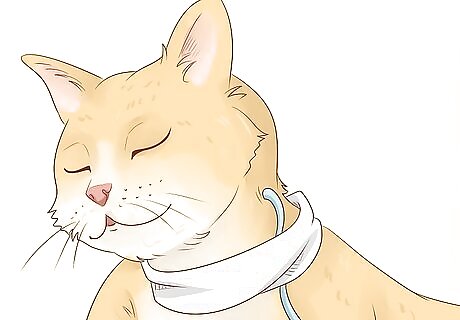
Tube-feed your cat. If your cat has trouble eating by mouth, they may need to be fed through a feeding tube. There are a variety of types of feeding tube, which may be inserted into the cat’s nose, throat (through an incision on the neck), or directly into the stomach through an incision in the side of the cat’s body. Liquid food is slowly inserted into the feeding tube through a syringe. Ask your vet for detailed instructions on the best way to tube feed your cat. The amount and type of food you give, and the number of feedings per day, will depend on your cat’s needs. Pay careful attention to your vet’s instructions for keeping the syringe and the area around the tube clean, in order to minimize the risk of infection.

Give your cat subcutaneous fluids. If your cat is especially dehydrated, has impaired kidney function, or is having trouble drinking, you may need to administer fluids directly under the skin through a catheter attached to a drip bag. Subcutaneous fluids may need to be given a few times a week, or as often as once a day. Ask your vet for instructions on how to give your cat subcutaneous fluids. The amount of fluid and the frequency of administration will vary depending on your cat’s needs.




















Comments
0 comment